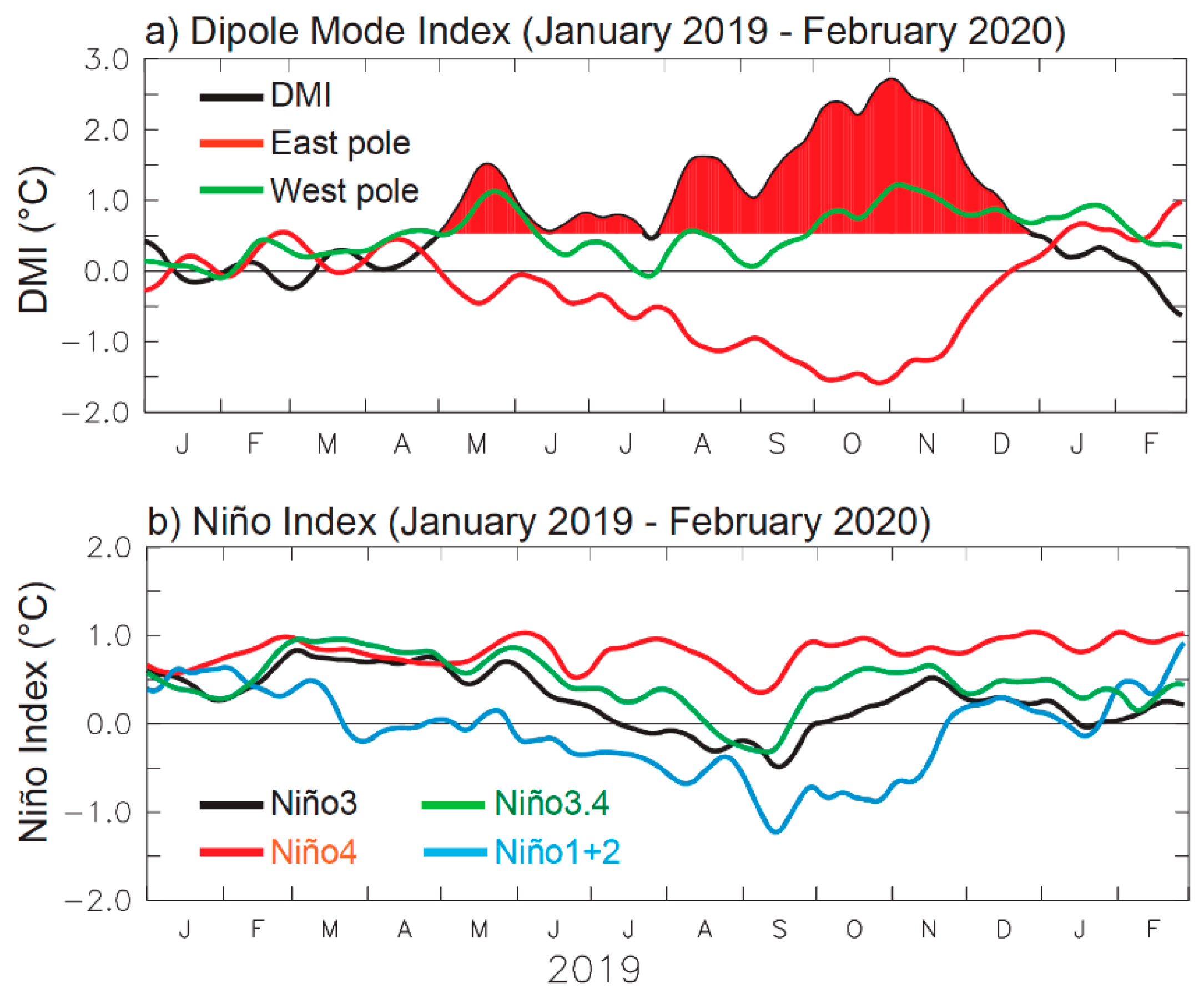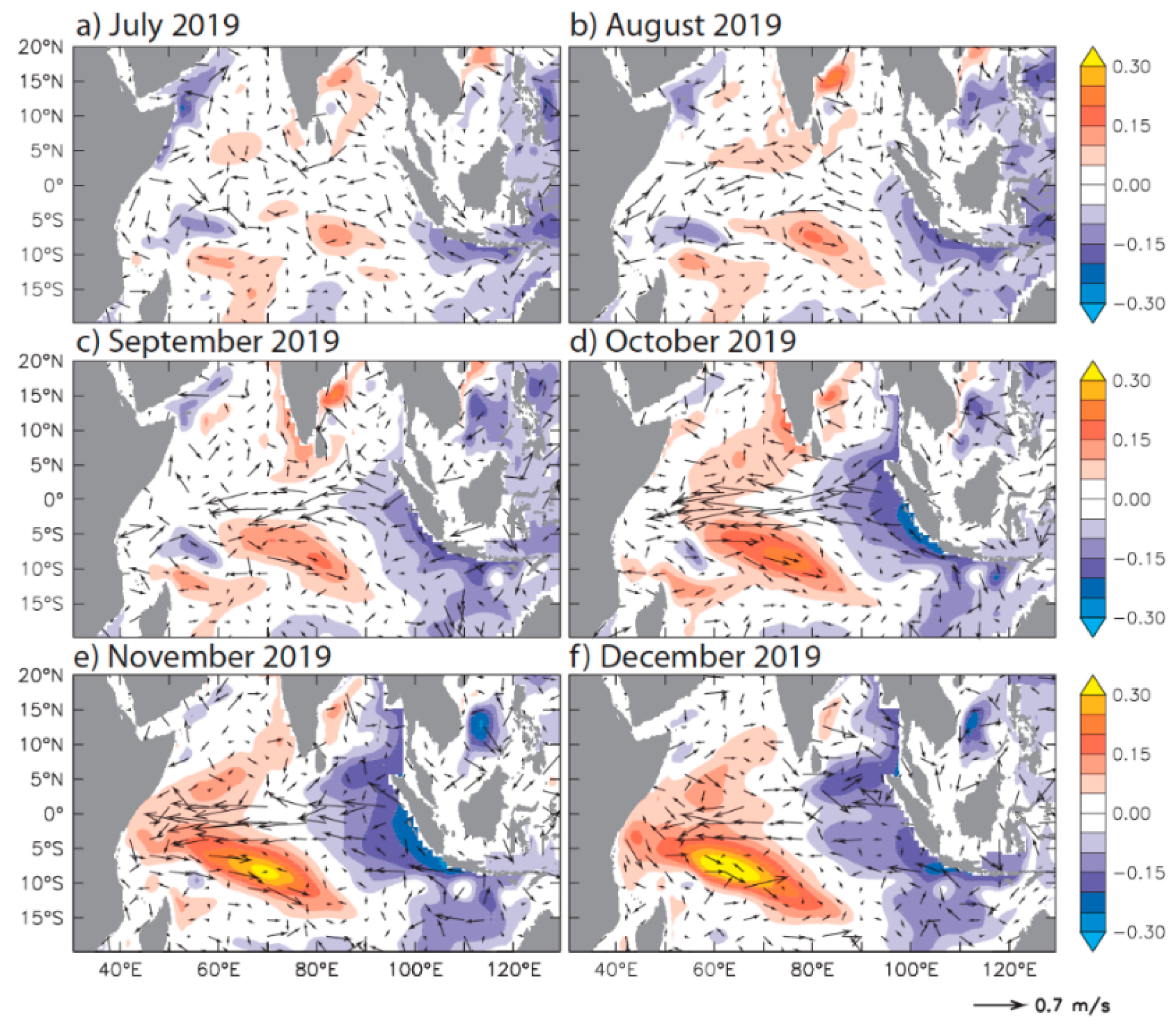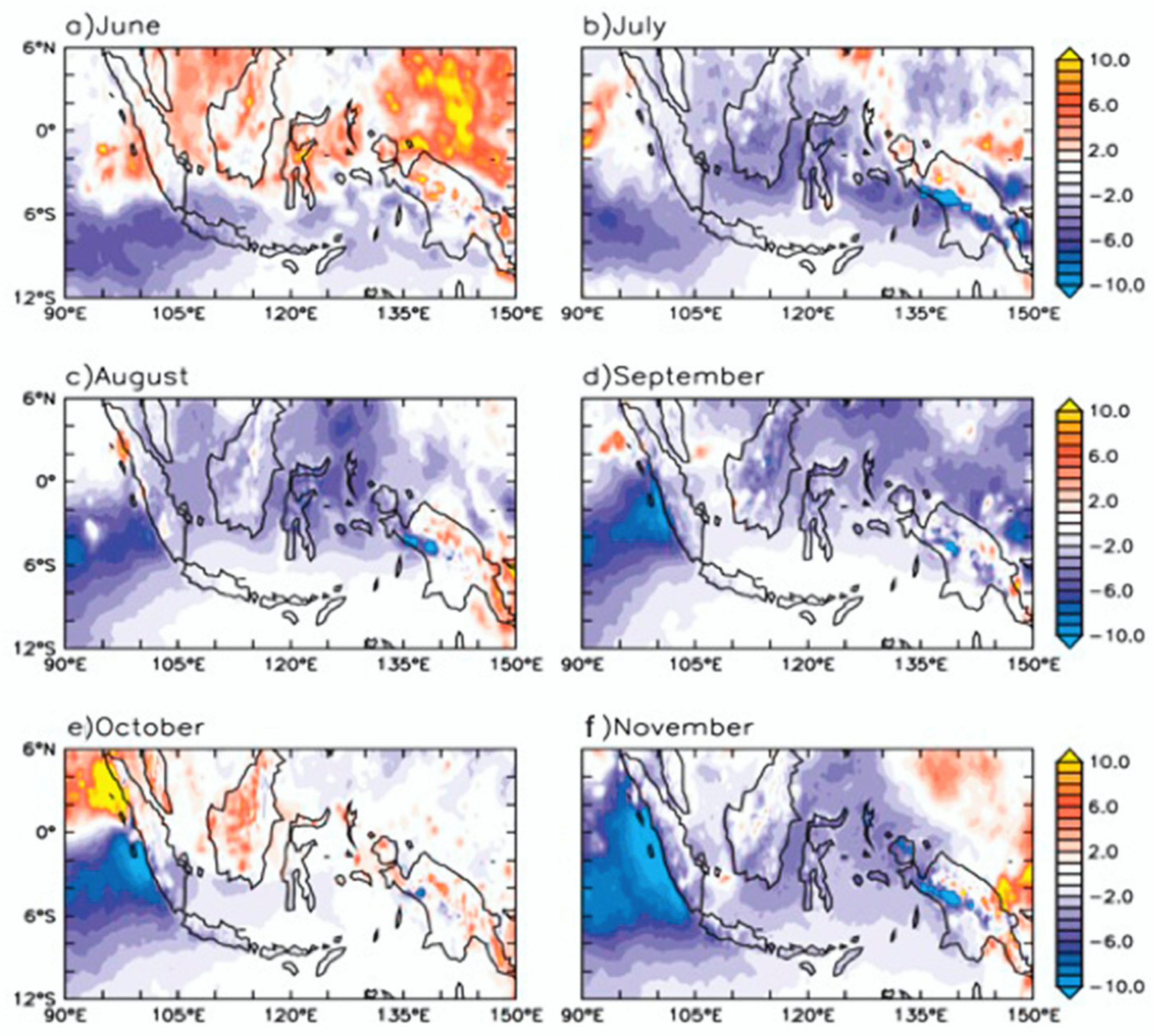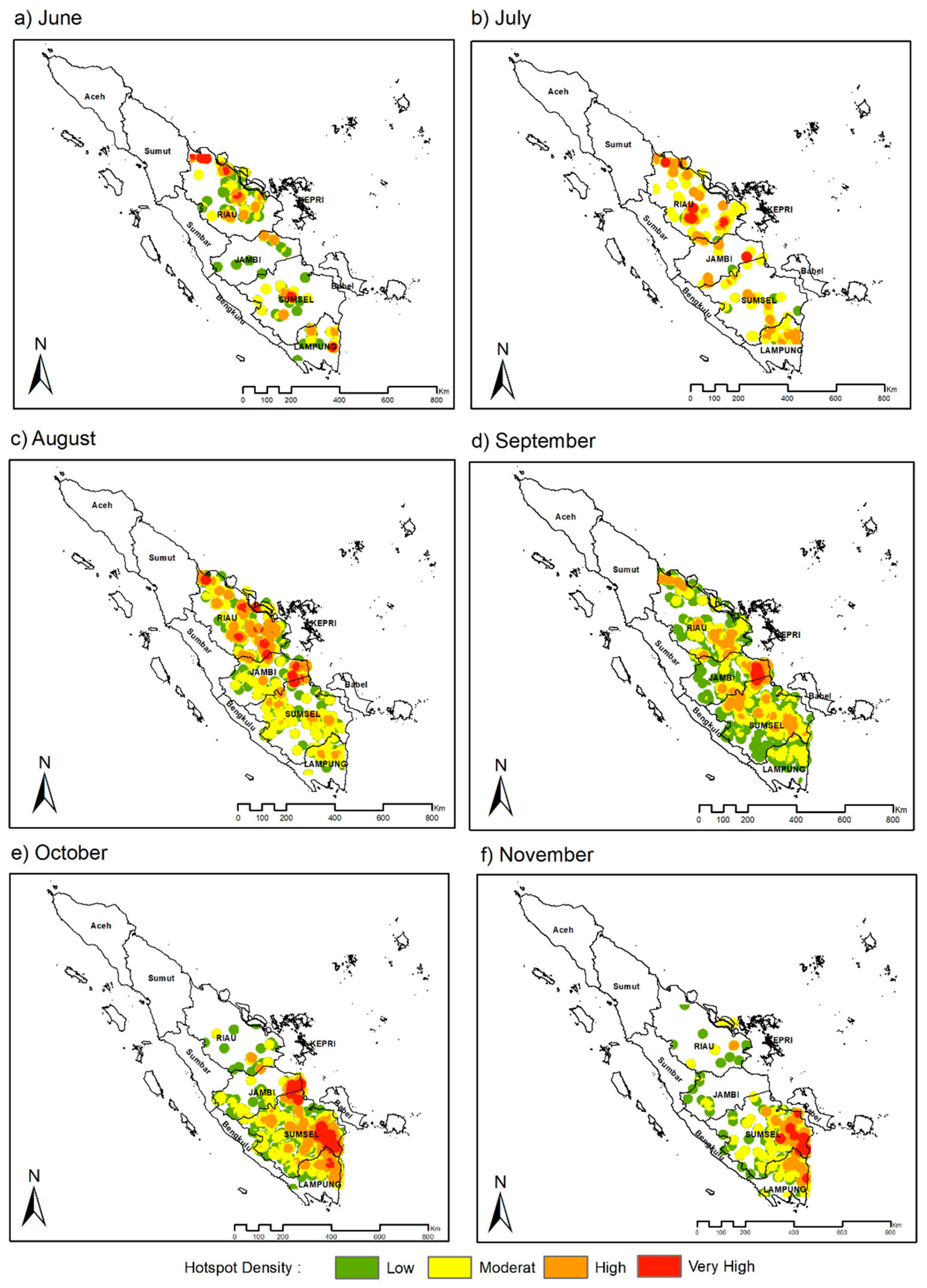Extreme Positive Indian Ocean Dipole in 2019 and Its Impact on Indonesia
Abstract
:1. Introduction
2. Data and Methods
2.1. Data
2.2. Method
3. Results
3.1. Evolution of the Extreme Positive Indian Ocean Dipole in 2019
3.2. Comparison with Previous Positive Indian Ocean Dipole
3.3. Impact of the Extreme Positive Indian Ocean Dipole in 2019
4. Conclusions
Author Contributions
Funding
Institutional Review Board Statement
Informed Consent Statement
Data Availability Statement
Acknowledgments
Conflicts of Interest
References
- Saji, N.H.; Goswami, B.N.; Vinayachandran, P.N.; Yamagata, T. A dipole mode in the tropical Indian Ocean. Nature 1999, 401, 360–363. [Google Scholar] [CrossRef] [PubMed]
- Webster, P.J.; Moore, A.; Loschnigg, J.P.; Leben, R.R. Coupled ocean-atmosphere dynamics in the Indian Ocean during 1997–1998. Nature 1999, 401, 356–360. [Google Scholar] [CrossRef] [PubMed]
- Murtugudde, R.; McCreary, J.P.; Busalacchi, A.J. Oceanic processes associated with anomalous events in the Indian Ocean with relevance to 1997-1998. J. Geophys. Res. Earth Surf. 2000, 105, 3295–3306. [Google Scholar] [CrossRef] [Green Version]
- Yamagata, T.; Behera, S.K.; Luo, J.; Masson, S.; Jury, M.R.; Rao, S.A. Coupled ocean-atmosphere variability in the tropical Indian Ocean. Geophys. Monogr. Ser. 2004, 147, 189–211. [Google Scholar] [CrossRef]
- McPhaden, M.J.; Nagura, M. Indian Ocean dipole interpreted in terms of recharge oscillator theory. Clim. Dyn. 2014, 42, 1569–1586. [Google Scholar] [CrossRef]
- Sahu, N.; Behera, S.K.; Yamashiki, Y.; Takara, K.; Yamagata, T. IOD and ENSO impacts on the extreme stream-flows of Citarum river in Indonesia. Clim. Dyn. 2012, 39, 1673–1680. [Google Scholar] [CrossRef]
- Sahu, N.; Robertson, A.W.; Boer, R.; Behera, S.; DeWitt, D.G.; Takara, K.; Kumar, M.; Singh, R.B. Probabilistic seasonal streamflow forecasts of the Citarum River, Indonesia, based on general circulation models. Stoch. Environ. Res. Risk Assess 2017, 31, 1747–1758. [Google Scholar] [CrossRef]
- Putra, R.; Sutriyono, E.; Kadir, S.; Iskandar, I.; Lestari, D.O. Dynamical link of peat fires in South Sumatra and the climate modes in the Indo-Pacific region. Indones. J. Geogr. 2019, 51, 18–22. [Google Scholar] [CrossRef] [Green Version]
- Pan, X.; Chin, M.; Ichoku, C.M.; Field, R.D. Connecting Indonesian Fires and Drought With the Type of El Niño and Phase of the Indian Ocean Dipole During 1979–2016. J. Geophys. Res. Atmos. 2018, 123, 7974–7988. [Google Scholar] [CrossRef]
- Cai, W.; Cowan, T.; Raupach, M. Positive Indian Ocean Dipole events precondition southeast Australia bushfires. Geophys. Res. Lett. 2009, 36, L19710. [Google Scholar] [CrossRef]
- Wang, G.; Cai, W. Two-year consecutive concurrences of positive Indian Ocean Dipole and Central Pacific El Niño preconditioned the 2019/2020 Australian “black summer” bushfires. Geosci. Lett. 2020, 7, 19. [Google Scholar] [CrossRef]
- Ratna, S.B.; Cherchi, A.; Osborn, T.J.; Joshi, M.; Uppara, U. The Extreme Positive Indian Ocean Dipole of 2019 and Associated Indian Summer Monsoon Rainfall Response. Geophys. Res. Lett. 2021, 48, e2020GL091497. [Google Scholar] [CrossRef]
- Shi, W.; Wang, M. A biological Indian Ocean Dipole event in 2019. Sci. Rep. 2021, 11, 2452. [Google Scholar] [CrossRef] [PubMed]
- Du, Y.; Zhang, Y.; Zhang, L.Y.; Tozuka, T.; Ng, B.; Cai, W. Thermocline Warming Induced Extreme Indian Ocean Dipole in 2019. Geophys. Res. Lett. 2020, 47, e2020GL090079. [Google Scholar] [CrossRef]
- Lu, B.; Ren, H.L. What Caused the Extreme Indian Ocean Dipole Event in 2019? Geophys. Res. Lett. 2020, 47, e2020GL087768. [Google Scholar] [CrossRef]
- Wang, G.; Cai, W.; Yang, K.; Santoso, A.; Yamagata, T. A Unique Feature of the 2019 Extreme Positive Indian Ocean Dipole Event. Geophys. Res. Lett. 2020, 47, e2020GL088615. [Google Scholar] [CrossRef]
- Aparna, A.R.; Girishkumar, M.S. Mixed layer heat budget in the eastern equatorial Indian Ocean during the two consecutive positive Indian Ocean dipole events in 2018 and 2019. Clim. Dyn. 2022, 58, 3297–3315. [Google Scholar] [CrossRef]
- Giglio, L.; Schroeder, W.; Hall, J.V.; Justice, C.O. MODIS Collection 4 Active Fire Product Use’ s Guide Table of Contents; Revisión B; Science Systems and Applications, Inc.: Lanham, MD, USA, 2018; Volume 1. [Google Scholar]
- Sari, Q.W.; Utari, P.A.; Setiabudidaya, D.; Yustian, I.; Siswanto, E.; Iskandar, I. Surface chlorophyll-a variations in the Southeastern Tropical Indian Ocean during various types of the positive Indian Ocean Dipole events. Int. J. Remote Sens. 2020, 41, 171–184. [Google Scholar] [CrossRef]
- Wirasatriya, A.; Setiawan, R.Y.; Subardjo, P. The Effect of ENSO on the Variability of Chlorophyll-a and Sea Surface Temperature in the Maluku Sea. IEEE J. Sel. Top. Appl. Earth Obs. Remote Sens. 2017, 10, 5513–5518. [Google Scholar] [CrossRef]
- Trenberth, K.E. The Definition of El Niño. Bull. Am. Meteorol. Soc. 1997, 78, 2771–2777. [Google Scholar] [CrossRef]
- Horii, T.; Hase, H.; Ueki, I.; Masumoto, Y. Oceanic precondition and evolution of the 2006 Indian Ocean dipole. Geophys. Res. Lett. 2008, 35, 1–6. [Google Scholar] [CrossRef]
- Iskandar, I.; Nagura, M.; McPhaden, M.J. Role of the eastern boundary-generated waves on the termination of 1997 Indian Ocean Dipole event. Geosci. Lett. 2021, 8, 35. [Google Scholar] [CrossRef]
- Rao, S.A.; Behera, S.K.; Masumoto, Y.; Yamagata, T. Interannual subsurface variability in the tropical Indian Ocean with a special emphasis on the Indian Ocean Dipole. Deep. Res. Part II Top. Stud. Oceanogr. 2002, 49, 1549–1572. [Google Scholar] [CrossRef]
- Feng, M.; Meyers, G. Interannual variability in the tropical Indian Ocean: A two-year time-scale of Indian Ocean Dipole. Deep. Res. Part II Top. Stud. Oceanogr. 2003, 50, 2263–2284. [Google Scholar] [CrossRef] [Green Version]
- Vinayachandran, P.N.; Iizuka, S.; Yamagata, T. Indian Ocean dipole mode events in an ocean general circulation model. Deep. Res. Part II Top. Stud. Oceanogr. 2002, 49, 1573–1596. [Google Scholar] [CrossRef]
- Vinayachandran, P.N.; Kurian, J.; Neema, C.P. Indian Ocean response to anomalous conditions in 2006. Geophys. Res. Lett. 2007, 34, 1–6. [Google Scholar] [CrossRef]
- Aldrian, E.; Susanto, R.D. Identification of three dominant rainfall regions within Indonesia and their relationship to sea surface temperature. Int. J. Climatol. 2003, 23, 1435–1452. [Google Scholar] [CrossRef]
- Utari, P.A.; Khakim, M.Y.N.; Setiabudidaya, D.; Iskandar, I. Dynamics of 2015 positive Indian Ocean Dipole. J. South. Hemisph. Earth Syst. Sci. 2019, 69, 75. [Google Scholar] [CrossRef]
- Lestari, D.O.; Sutriyono, E.; Sabaruddin, S.; Iskandar, I. Respective Influences of Indian Ocean Dipole and El Niño-Southern Oscillation on Indonesian Precipitation. J. Math. Fundam. Sci. 2018, 50, 257–272. [Google Scholar] [CrossRef] [Green Version]
- Lee, H. General Rainfall Patterns in Indonesia and the Potential Impacts of Local Seas on Rainfall Intensity. Water 2015, 7, 1751–1768. [Google Scholar] [CrossRef]
- Huijnen, V.; Wooster, M.J.; Kaiser, J.W.; Gaveau, D.L.A.; Flemming, J.; Parrington, M.; Inness, A.; Murdiyarso, D.; Main, B.; Van Weele, M. Fire carbon emissions over maritime southeast Asia in 2015 largest since 1997. Sci. Rep. 2016, 6, 26886. [Google Scholar] [CrossRef] [PubMed]
- Wooster, M.J.; Perry, G.L.W.; Zoumas, A. Fire, drought and El Niño relationships on Borneo (Southeast Asia) in the pre-MODIS era (1980–2000). Biogeosciences 2012, 9, 317–340. [Google Scholar] [CrossRef] [Green Version]
- Iskandar, I.; Rao, S.A.; Tozuka, T. Chlorophyll-a bloom along the southern coasts of Java and Sumatra during 2006. Int. J. Remote Sens. 2009, 30, 663–671. [Google Scholar] [CrossRef]









Publisher’s Note: MDPI stays neutral with regard to jurisdictional claims in published maps and institutional affiliations. |
© 2022 by the authors. Licensee MDPI, Basel, Switzerland. This article is an open access article distributed under the terms and conditions of the Creative Commons Attribution (CC BY) license (https://creativecommons.org/licenses/by/4.0/).
Share and Cite
Iskandar, I.; Lestari, D.O.; Saputra, A.D.; Setiawan, R.Y.; Wirasatriya, A.; Susanto, R.D.; Mardiansyah, W.; Irfan, M.; Rozirwan; Setiawan, J.D.; et al. Extreme Positive Indian Ocean Dipole in 2019 and Its Impact on Indonesia. Sustainability 2022, 14, 15155. https://doi.org/10.3390/su142215155
Iskandar I, Lestari DO, Saputra AD, Setiawan RY, Wirasatriya A, Susanto RD, Mardiansyah W, Irfan M, Rozirwan, Setiawan JD, et al. Extreme Positive Indian Ocean Dipole in 2019 and Its Impact on Indonesia. Sustainability. 2022; 14(22):15155. https://doi.org/10.3390/su142215155
Chicago/Turabian StyleIskandar, Iskhaq, Deni Okta Lestari, Agus Dwi Saputra, Riza Yuliratno Setiawan, Anindya Wirasatriya, Raden Dwi Susanto, Wijaya Mardiansyah, Muhammad Irfan, Rozirwan, Joga Dharma Setiawan, and et al. 2022. "Extreme Positive Indian Ocean Dipole in 2019 and Its Impact on Indonesia" Sustainability 14, no. 22: 15155. https://doi.org/10.3390/su142215155
APA StyleIskandar, I., Lestari, D. O., Saputra, A. D., Setiawan, R. Y., Wirasatriya, A., Susanto, R. D., Mardiansyah, W., Irfan, M., Rozirwan, Setiawan, J. D., & Kunarso. (2022). Extreme Positive Indian Ocean Dipole in 2019 and Its Impact on Indonesia. Sustainability, 14(22), 15155. https://doi.org/10.3390/su142215155








